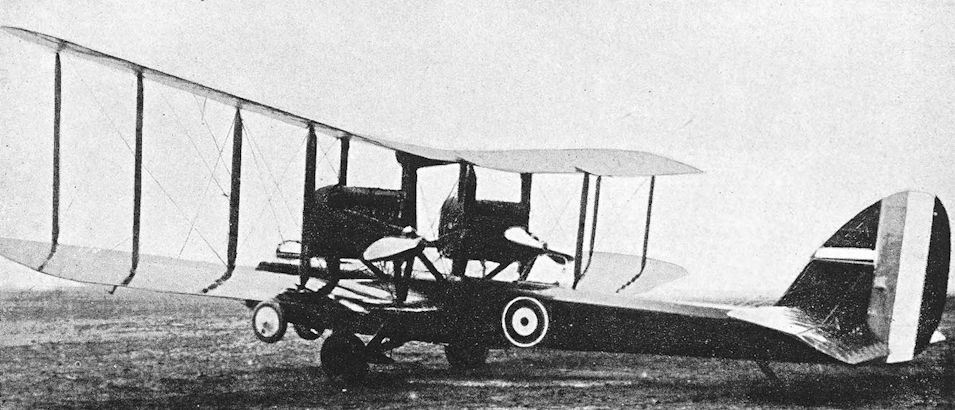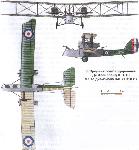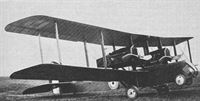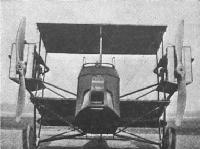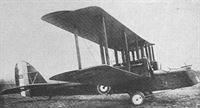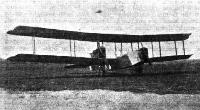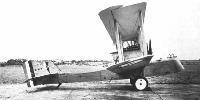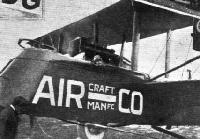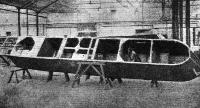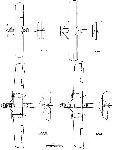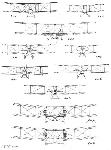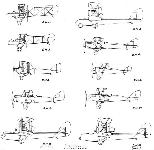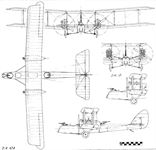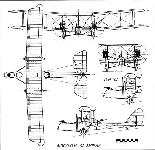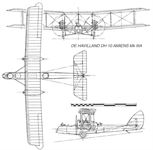А.Шепс Самолеты Первой мировой войны. Страны Антанты
Потребность фронта в двухмоторном бомбардировщике, способном нести значительную бомбовую нагрузку вместе с фирмами "Шорт Бразерс" и "Блэкборн" пыталась удовлетворить и фирма "Де Хевилленд".
В 1917 году был спроектирован и построен двухмоторный фронтовой бомбардировщик D.H.10. Это был трехстоечный биплан цельнодеревянной конструкции. Фюзеляж имел прямоугольное сечение и обшивался в носовой части фанерой, а в хвостовой части полотном. В носовой части и за задней кромкой центроплана устанавливались пулеметные турели. За носовой турелью располагалась кабина пилота. Крыло двухлонжеронное, деревянной конструкции, имело фюзеляжные нервюры и стойки бипланной коробки из металлических труб с деревянными обтекателями. Растяжки из стальной профилированной ленты. Оперение обычной конструкции. Стабилизатор регулируемый. Киль и рули имели деревянную конструкцию и обтягивались полотном. К фюзеляжу и килю стабилизатор крепился подкосами и растяжками.
Управление рулями тросовое, от штурвала и педалей. На самолете устанавливались двигатели "Либерти" мощностью по 400 л. с. Это были 12-цилиндровые, жидкостного охлаждения, рядные, V-образные двигатели с лобовыми радиаторами и двухлопастными винтами. Шасси пирамидальное со шнуровой резиновой амортизацией и хвостовым костылем. Вооружение состояло из двух-четырех 7,62-мм пулеметов "Льюис". Машина могла нести более 400 кг бомб на внешней подвеске. В дивизионы самолеты начали поступать весной 1918 года и успели принять участие в заключительных боях войны, показав неплохие летно-технические качества. После войны некоторые машины были переоборудованы для перевозки грузов и почты и эксплуатировались до середины 1920-х годов.
Размеры, м:
длина 11,20
размах крыльев 20,00
высота 3,99
Площадь крыла, мг 77,20
Вес, кг:
максимальный взлетный 4100 кг
пустого 2550 кг
Двигатели: "Либерти"
число х мощность, л.с. 2x400
Скорость, км/ч 180
Дальность полета, км 700
Потолок практический, м 4900
Экипаж, чел. 3
Вооружение 2-4 пулемета, 410 кг бомб
Показать полностью
A.Jackson De Havilland Aircraft since 1909 (Putnam)
De Havilland D.H. 10 Amiens
German bombing successes in 1917 over London, the Home Counties and along the East Coast, using twin engined aircraft, forced the Air Board to take retaliatory action and to renew its interest in the D.H.3. A contract was therefore placed with the Aircraft Manufacturing Co. Ltd. for prototypes of a somewhat larger version designated the D.H. 10. The aircraft was structurally similar to its predecessor, the airframe being of spruce and ash construction, with fabric covered mainplanes. The fuselage consisted of a plywood covered, box-like front portion to which was bolted the usual Warren girder tail section. Rudder and elevator trailing edges were of steel tubing to simplify the creation of artistic outline and to reduce the risk of accidental damage on the ground. Steel tubing was also used for the wide track, divided undercarriage and for engine nacelle struts, the latter being faired to streamline shape with fabric doped over wooden formers. Two 230 h.p. B.H.P. watercooled engines were mounted as pushers and to give adequate airscrew clearance cut outs were made in the trailing edges of upper and lower mainplanes as on the D.H.3A. The crew of three comprised front and rear gunners and pilot, but full dual control was fitted in the rear gunner's cockpit, the rudder bar being covered by hinged floorboards when not in use.
The prototype D.H. 10 C4283, flew for the first time on March 4, 1918, but its performance was 6% down on estimate and it could carry only a small military load. The third and fourth prototypes were therefore fitted with more powerful engines arranged to drive tractor instead of pusher airscrews, the third, C8659, flying for the first time on April 20, 1918, with 360 h.p. Rolls-Royce Eagle VIIIs. The first two prototypes were therefore the only D.H. 10s to have the cut out trailing edges. Engines of even greater power - 400 h.p. Liberty 12s - were fitted to the fourth prototype C8660, which was the true pre-production version without nose wheels. It was built with 2 1/2 instead of 4 degrees of mainplane sweepback, elongated nacelles, Scarff rings for front and rear gunners and horn balanced ailerons. Fuel was carried in the front fuselage in two 98 gallon tanks, between which was a bay accommodating some 900 lb. of bombs. Additional bomb loads were carried on external racks under the lower mainplane.
When the prototypes were ordered, the Air Board gave the D.H.10 the type name Amiens, so that the first two prototypes were Amiens Mk. I, the third Mk. II, while the fourth and all production aircraft were Amiens Mk. III. Due no doubt to the rapid winding up of production at the end of the war, this type name was little used and its very existence lay forgotten in official files for close on 40 years. Although orders were placed with the parent company and six sub-contractors for 1,295 D.H. 10s, only eight were on R.A.F. charge at the end of hostilities. Thus a most promising and worthy successor to the immortal D.H.4 arrived too late to see active war service, and the subsequent history of the type was one of technical refinement and mail carrying. Improvement in performance by mounting the engines directly on the lower mainplane in order to eliminate the enormous parasitic drag of the original strutted arrangement, gave rise to the Mann, Egerton-built D.H.10A Amiens Mk. IIIA with Liberty engines. These were given an appreciable degree of upthrust and the aircraft was also equipped with heavy duty wheels. When Liberty deliveries ceased at the end of 1918 an up-rated Rolls-Royce Eagle VIII of 375 h.p. became the standard engine of a final version known as the D.H.10C Amiens Mk. IIIC.
The first major experimental modification to the D.H.10 was the installation of a 1 1/2 pounder Coventry Ordnance Works quick firing gun in D.H. 10 E5458 and D.H. 10C E5550 for trials at Orfordness. Each had an enlarged bow cockpit and the old familiar nose wheels but trials were discontinued when air firing tests resulted in the crash of E5458.
The third investigation was devoted to improving asymmetrical flying in the event of engine failure and a production D.H. 10 E6042 was modified by Airco and tested at Farnborough in 1921 with twin fins and rudders of typical D.H. outline. A rectangular central fin was next added for comparison and in 1922 the entire assembly was replaced by an experimental tail unit with an immense horn balanced single rudder 39 sq. ft. in area as compared with the usual 25 sq. ft. In 1923 the aircraft was flown with twin rectangular rudders and between April 29, 1924 and May 22, 1926, fifteen or twenty test flights were made with the standard D.H. 10 rudder equipped with a small servo rudder on outriggers.
In the peacetime R.A.F. the D.H. 10 was used by No. 120 Squadron for the air mail service to the British Army of Occupation on the Rhine, daily flights being made between Hawkinge and Cologne. A D.H. 10 piloted by Capt. Barratt which left Hawkinge at 10.15 p.m. on May 14, 1919 and arrived at Cologne 3 1/4 hours later, was the first aircraft ever to carry mails at night. Most of the D.H. 10s in India were sold as scrap at Ambala in February 1922 but a few were retained to police the North West Frontier with No. 97 Squadron and to carry the desert air mail between Cairo and Baghdad until superseded by Vickers Vimys in 1923. For this purpose they were fitted with an additional cockpit behind the pilot, e.g. E5507. One of the last recorded appearances of a D.H. 10 was at the No. 7 Group Display, Andover on June 23, 1923 when F/O. J. S. Chick performed a dog fight with two S.E.5As.
The designation D.H.10B is generally supposed to have been reserved for a purely civil mail carrying version but only two aircraft were used for this purpose in England. Both were operated by Aircraft Transport and Travel Ltd. but neither was actually known as a D.H.10B because the first was the D.H. 10C prototype E5557 and the other a demilitarized D.H. 10 E5488, civil registered as G-EAJO. The latter was granted a full civil C. of A. before demonstration at the ELTA Exhibition at Amsterdam in August 1919 by Capt. Gerald Gathergood and on September 30th joined E5557 on regular mail flights between Hendon, Newcastle and Renfrew in an attempt to break the railway strike. A scheme was also considered for a conversion to carry pilot and four passengers, two side by side in the nose and two in the rear, the starboard passengers facing aft and the port forward.
At least one D.H. 10 supplemented the DH-4s on United States air mail routes. Powered by two Liberty VI engines and numbered 111, it had completed 31 hours 27 minutes flying on the New York-Cleveland-Omaha route by June 1920, average flying time for the initial stage of 200 miles being 3 hours.
SPECIFICATION AND DATA
Manufacturers:
The Aircraft Manufacturing Co. Ltd., Hendon, London, N.W.9
The Alliance Aeroplane Co. Ltd., Cambridge Road, London, W.14
The Birmingham Carriage Co., Birmingham
The Daimler Co. Ltd., Coventry
Mann, Egerton and Co. Ltd., Aylsham Road, Norwich, Norfolk
National Aircraft Factory No.2, Heaton Chapel, Stockport
The Siddeley-Deasy Motor Car Co. Ltd., Parkside, Coventry
Power Plants:
(D.H.10 Amiens Mk. I) Two 230 h.p. B.H.P.
(D.H.10 Amiens Mk. II) Two 360h.p. Rolls-Royce Eagle VIII
(D.H.10 Amiens Mk. III) Two 400 h.p. Liberty 12
(D.H.10A Amiens Mk. IIIA) Two 400 h.p. Liberty 12
(D.H.10C Amiens Mk. IIIC) Two 375 h.p. Rolls-Royce Eagle VIII
Dimensions, Weights and Performances:
Mk. I Mk. II Mk. III Mk. IIIA
Span 62 ft. 9 in. 62 ft. 9 in. 65 ft. 6,in. 65 ft. 6 in.
Length 38 ft. 10 in. 38 ft. 10 in. 39 ft. 7 1/2in. 39 ft. 7 1/2 in.
Height 14 ft. 6 in. 14 ft. 6 in. 14 ft. 6 in. 14 ft. 6 in.
Wing area 789 3/4 sq. ft. 834 3/4 sq. ft. 837 1/2 sq. ft. 837 1/2 sq. ft.
Tare weight 5,004 lb. 5,585 lb. 5,750 lb.
All-up weight 6.950 lb. 8,500 lb. 9.000 lb. 9,000 lb.
Maximum speed 109 m.p.h. 117 1/2 m.p.h. 129 m.p.h.
Climb
to 6,500 ft. 11 min. 25 sec. 9 min. 7 min.
Service ceiling 15,000 ft. 16,500 ft. 17,500 ft.
Endurance 3 1/2 hours 5 3/4 hours 5 3/4 hours
Production: The following serial numbers were allotted to D.H. 10s but many were not completed.
Serial range Manufacturer Serial range Manufacturer
C8658 to C8660 Airco *F351 to F550 N.A.F. 2
E5437 to E5636 Airco F1867 to F1882 Airco
E6037 to E6136 Birmingham Carriage Co. F7147 to F7346 Alliance
E7837 to E7986 Siddeley-Deasy F8421 to F8495 Mann. Egerton
E9057 to E9206 Daimler H2746 to H2945 Airco
* Believed F351 to F355 only. F352 crashed 2.19.
Service Use:
(a) In the United Kingdom Nos. 104 and 120 Squadrons.
(b) On the N.W. Frontier of India No. 60 (formerly No. 97) Squadron,
(c) In Egypt No. 216 Squadron.
Civil Conversions: G-EAJO, formerly E5488, C. of A. issued 18.8.19, crashed 4.20; at least No. 111 in America.
Показать полностью
F.Manson British Bomber Since 1914 (Putnam)
Airco D.H. 10 Amiens
It has been said, possibly apocryphally, that while the German bombers were attacking London in daylight on 7 July 1917, the sole D.H.3 twin-engine bomber prototype was being burnt in a scrapyard at Hendon. True or false, it is ironic that it required the daylight raids on the British capital to persuade the Air Board to reconsider its ill-judged opinion that twin-engine bombers were impractical, a view that had brought development of the D.H.3 to a premature end eighteen months earlier.
By the end of July 1917 Air Board Specification A.2.b had been drafted, calling for a single- or twin-engine day bomber with a two-man crew, capable of carrying bombs and racks weighing 500 lb at a height of at least 19,000 feet, with a maximum speed with this load at 15,000 feet of not less than 110 mph. Moreover, the Air Board's Technical Committee went a step further by expressing the view that the D.H.3, if fitted with two 200hp BHP engines, could meet this requirement, and straightway ordered a single prototype, C4283.
As work got underway on this aircraft, Geoffrey de Havilland started a radical redesign of the D.H.3, using 230hp Siddeley Puma engines in a slightly enlarged airframe, and on 18 October Airco was instructed to concentrate on this version, ordering three new prototypes, C8658-C8660, ten days later.
The first of the new prototypes, C8658, was flown at Hendon on 4 March 1918, cut-outs in the trailing edge of the upper wing being necessitated by the use of pusher propellers. This machine was delivered to Martlesham Heath on 7 April for evaluation, but failed by a substantial margin to meet the performance demands, being scarcely able to manage 90 mph at 15,000 feet with the stipulated bomb load.
This lack of performance had, however, been anticipated, and the second prototype, C8659, was flown on 20 April with 360hp Rolls-Royce Eagle VIIIs in tractor installations, becoming known as the Amiens Mark II - even though the Air Ministry explained that this version was unlikely to achieve production owing to heavy demand for this engine elsewhere. As with the D.H.9A, the Eagle installation was only undertaken to test the various airframe modifications introduced, not least those associated with the tractor engines. Indeed the Eagle installation was similar to that of the American 395hp Liberty 12 engine, selected for the finite production Amiens.
The prototype of this, the Amiens Mark III, C8660, was delivered to Martlesham Heath on 28 July, demonstrating a maximum sea level speed of about 120 mph while carrying four 230 lb bombs - well in excess of the speed and load demanded. It failed, however, to meet the load-at-altitude requirements by a slender margin. This aircraft also had the twin nosewheels removed - relics of the old D.H.3 design.
Meanwhile work had resumed on the original prototype, C4283, now referred to as the fourth prototype as it was intended to represent the Amiens Mark III in its production guise. With raked wing tips and horn-balanced ailerons, and 405hp Liberty 12 high-compression engines, it exceeded all the speed, altitude and load requirements.
The first major alteration to production D.H. 10s involved mounting the engine nacelles on the lower wings instead of at mid-gap and, following a favourable report from Martlesham, this modification was introduced into Mann, Egerton's production line at Norwich as the Amiens IIIa, of which 32 were produced. All production D.H. 10s were covered by the Air Ministry's Specification Type VII, issued in April 1918.
The only other significant variant was the D.H. 10C Amiens IIIc, powered by 375hp Eagle VIIIs, but this was no more than a shortlived insurance against discontinuation of Liberty production in America. As far as can be discovered only five examples were produced, all random installations in Airco's final production batch. Two of these, E5458 and E5550, were experimentally armed with the 11/2-pounder COW gun for trials at Ordfordness in 1920.
The general uncertainty of and delays in the delivery of Liberty engines during 1918 was the cause o f the production of Amiens aircraft falling further and further behind schedule during the last six months of the War, and it had been planned to have the aircraft in service with eight squadrons of the Independent Force by the spring o f 1919. A total of 1,291 D.H. 10s was on order with seven companies by November 1918, but only eight had been delivered by that month. Post-Armistice cancellations then reduced to actual number built to just 258. More than 100 of these remained in store until the aircraft was declared obsolete in April 1923.
Postwar Service
In the event the D.H. 10 only fully equipped Nos 97 (becoming No 60), 104 and 216 Squadrons, and none gave service as a bomber in the United Kingdom. Moreover, its Service life only spanned the period between November 1918 and April 1923.
First deliveries were made to No 104 Squadron in the first half of November 1918, then based at Maisoncelle in France, and it was with this unit that the Amiens flew its one and only wartime operation when on the day before the Armistice, F1867, flown by Capt Ewart Garland, joined a raid on Sarrebourg in Lorraine. No 104 gave up its aircraft in February 1919, returned to the United Kingdom and disbanded six months later.
In the meantime No 97 Squadron, hitherto equipped with Handley Page O/400s, had returned to England and began taking on a full complement of D.H. 10s at Ford in January, the first two Airco-built examples, E5450 and E5456, arriving that month. In July the Squadron sailed for India, and between August and November took delivery of tropicalised D.H. 10s, identified by taller radiators to provide extra cooling of the Libertys.
On 1 April 1920 No 97 Squadron was renumbered No 60 while at Lahore, and the new Squadron took charge of the D.H. 10s, moving to Risalpur to provide support for the ground forces on the North-West Frontier.
That same month the Squadron's Amiens helped the army to suppress the Pathan revolt that marked the climax of the Third Afghan War, but another Pathan rising in November brought further air action when D.H. 10s, in company with other RAF bombers, attacked bands o f rebel tribesmen in the Tilli area. No 60 Squadron continued to fly its Amiens until April 1923 when they were replaced by D.H.9As.
The only other Squadron to be fully equipped with D.H.10s was No 216 at Abu Sueir in Egypt, which received its first Amiens in December 1919, with eight further machines arriving during the next six months. To begin with, the D.H. 10s were flown by one Flight, charged with pioneering an air mail service between Cairo and Baghdad, while, until October 1921, the other Flight continued to fly O/400 heavy bombers. Owing to the low weight of mail payloads, No 216 Squadron simultaneously flew a 'taxi' service in the mail aircraft, adding a second cockpit behind that of the pilot. In June 1922, with the arrival of Vimys, the D.H. 10s became redundant as the Vickers aircraft could more efficiently perform passenger, mail and bombing duties on its own.
Amiens aircraft also served in small numbers with other Squadrons, including one (E5459) with No 24 at Kenley in the communications role, two with No 27 Squadron for bombing duties on the North-West Frontier late in 1922, one (the first prototype, C8658) with No 51 Squadron in Norfolk during 1918 for evaluation as a heavy fighter, and one with No 120 Squadron for an experimental night mail service between Hawkinge in Kent and Cologne during May 1919.
Another experimental Amiens was the Birmingham Carriage Company-built E6042, which underwent prolonged trials with various tail configurations, including twin fins and rudders; first delivered to the RAE at Farnborough on 25 October 1919, it was last flown on 8 July 1926.
A few Amiens trainers with dual controls were produced for No 6 Flying Training School at Manston, and at least one of these was flying in 1922.
Type: Twin-engine, three-crew, three-bay biplane medium bomber.
Specification: Air Board (1917) Specification A.2.B
Manufacturers: The Aircraft Manufacturing Co Ltd, Hendon, London NW9; Birmingham Carriage Co, Birmingham; The Daimler Co Ltd, Coventry; Mann, Egerton & Co Ltd, Aylsham Road, Norwich, Norfolk; The Siddeley-Deasey Motor Car Co Ltd, Parkside, Coventry; National Aircraft Factory No 2, Stockport.
Powerplant: Mark I. Two 230hp BHP six-cylinder liquid-cooled in-line engines driving two-blade pusher propellers. Mark II. Two 360hp Rolls-Royce Eagle VIII twelve-cylinder liquid-cooled in-line engines driving two-blade tractor propellers. Mark III and IIIA. Two 400hp Liberty 12 engines. Mark IIIC. Two 375hp Rolls-Royce Eagle VIII engines.
Structure: All-wood, wire-braced box structure; forward fuselage ply-covered, rear fabric-covered. Twin laminated spruce wing spars with ash ribs and silver spruce interplane struts.
Dimensions (Mark IIIA): Span, 65ft 6in; length, 39ft 7 1/16in; height, 14ft 6in; wing area, 837.4 sq ft.
Weights (Mark IIIA): Tare, 5,750 lb; all-up (with bomb load), 9,060 lb
Performance (Mark IIIA): Max speed, 131 mph at sea level, 124 mph at 10,000ft; climb to 10,000ft, 11 min; service ceiling, 19,000ft; endurance, 6 hr.
Armament: Bomb load of up to 920 lb (112 lb and 230 lb bombs or combinations) carried internally. Single- or double-yoked 0.303in Lewis machine guns with Scarff rings mounted on nose and midships gunners' cockpits.
Prototypes: Three, C8658-C8660. First aircraft, Mark I C8658, first flown by Capt Geoffrey de Havilland at Hendon on 4 March 1918. One other prototype, C4283, was converted to full Amiens III production standard.
Production: A total of 1,291 D.H.10s was ordered, but only 258 were built, as follows: Airco, 138 (E5437-E5558 and F1867-F1882, all D.H.10 Mark Ills); Birmingham Carriage, 20 (E6037-E6056, all Mark Ills); Siddeley-Deasey, 28 (E7837-E7864, all Mark Ills); Daimler, 40 (E9057-E9096, all Mark Ills); Mann, Egerton, 32 (F8421-F8452, all Mark IIIAs).
Summary of Service: D.H. 10 Mark Ills and IIIAs served with No 104 Squadron, RAF, in France between November 1918 and February 1919; with No 97 Squadron (renumbered No 60 Squadron on 1 April 1920) at Risalpur, India, between April 1919 and April 1923); and with No 216 Squadron at Abu Sueir and Heliopolis, Egypt, between December 1919 and June 1922. E5459 served with No 24 (Communications) Squadron at Kenley and London Colney in 1919; two D.H. 10s flew bombing operations with No 27 Squadron in India in 1922; one (C8658) was evaulated as a heavy fighter with No 51 Squadron, and one operated a night mail service with No 120 Squadron between Hawkinge and Cologne in May 1919.
Показать полностью
P.Lewis British Bomber since 1914 (Putnam)
A new twin-engine bomber, the D.H.10, was completed at Hendon at the beginning of 1918. The newcomer revived the layout of the 1916 D.H.3 but was slightly longer. The first prototype of four ordered was C8658, designated Amiens Mk. I, which made its first take-off on 4th March, 1918, powered by a pair of pusher 230 h.p. B.H.P. engines. The next machine, the Amiens Mk. II C8659, was equipped with two 360 h.p. Rolls-Royce Eagle VIIIs installed as tractors and first flew on 20th April, 1918. C8660, the third machine and designated Amiens Mk. III, received a pair of tractor 400 h.p. Liberty 12 engines. The fine performance of the Liberty-powered Mk. III resulted in this version being selected for production, and four hundred and fifty were ordered on 10th March, 1918. The Mk. III A version was equipped also with the 400 h.p. Liberty 12 but attached to the lower wings, while the Mk. IIIC used a pair of 375 h.p. Eagle VIIIs, likewise mounted on the lower planes. An excellent bomber design, the D.H.10 arrived too late to play any part in the war.
Показать полностью
J.Bruce British Aeroplanes 1914-1918 (Putnam)
de Havilland io and 10A, the Amiens
PROOF that the promise of the D.H.3 of 1916 had not been forgotten was provided early in 1918, when the first D.H.10 appeared. The relationship between the two machines was at once obvious, for the D.H.10 had the same underslung fuselage and wide-track split undercarriage. It was a three-seater designed for bombing duties, and was rather larger than the D.H.3.
The initial contract was for four prototypes. The first machine was powered by two 230 h.p. B.H.P. engines installed as pushers, thus duplicating the engine arrangement used on the earlier D.H.3, and also had two auxiliary wheels at the nose. There were cut-outs in the trailing edges of the wings to allow the airscrews to revolve. In this form the D.H.10 first flew on March 4th, 1918. Performance at an all-up weight of 6,950 lb was quite good, but it seems probable that this figure did not include an exceptionally large bomb load. An idea of using the original D.H.10 as a Home Defence aircraft seems to have been short-lived.
More powerful engines were tried in the other prototypes. The second machine, C.8659, had two 360 h.p. Rolls-Royce Eagle VIII engines installed as tractors, each driving a two-bladed airscrew. This machine first flew on April 20th, 1918. Both prototypes had plain ailerons which extended inboard as far as the second pair of interplane struts, and on C.8659 there were, of course, no cut-outs in the trailing edges of the wings.
The third prototype, C.8660, had two Liberty 12 engines driving two-bladed tractor airscrews. On this D.H.10 the Liberties were housed in rather massive nacelles which extended behind the trailing edges of the wings. The sweep-back of the mainplanes was slightly reduced and the ailerons were shorter than those of the first two prototypes, but a refinement was added in the shape of horn balances. With the Liberty engines the D.H.10 had an excellent performance, and it was this version which went into production. The shape of the nose was slightly modified, and the twin nosewheels were not fitted.
The type was officially named Amiens, but, strangely, the name has not survived. The first prototype with B.H.P. engines was designated Amiens Mk. I; the second, Eagle-powered, machine was the Mk. II, and the Liberty D.H.10 was the Amiens Mk. III.
Structurally, the D.H.10 differed little from its predecessors. The fuselage was a wooden structure: the forward portion was a plywood-covered box and the rear part was a conventional wire-braced boxgirder with fabric covering. The two parts were butt-jointed immediately behind the rear gunner’s cockpit. All longerons and spacers were of spruce. The lower centre-section was built integral with the fuselage: the spars entered the fuselage and were divided on the aircraft centre-line, where they were connected by special star-shaped brackets. The two lowest arms of these brackets held the upper ends of two oblique bracing struts which arose from the lower longerons, and the central top arm accommodated the bottom of each single centre-section strut.
The main fuel supply was carried in two 98-gallon tanks, one of which was situated immediately behind the pilot, and the other in front of the rear gunner’s cockpit. The space between the tanks was the bomb bay. A 19-gallon gravity tank was mounted in the upper centre-section. Dual control was provided in the rear gunner’s cockpit: the rudder bar was normally concealed by two doors in the floor of the cockpit.
The wings were conventional in construction. Spars were of laminated spruce; compression ribs were of ash three-ply with spruce capping; and the internal cross-bracing was of 2 B.A. tie rods. The aileron control cables ran inside the wings. The interplane struts were of silver spruce, and single Rafwires were used for bracing. The struts which carried the engine-bearers were of faired steel tube.
The tailplane had spruce spars, and its incidence could be controlled from the cockpit. The elevators had steel tube trailing edges. The fin and rudder were built in similar fashion; the fixed surface was wholly made of wood, whilst the trailing edge of the rudder was of steel tubing.
The eminently sensible undercarriage relied on rubber cord for shock absorption: 26 feet of 5/8-inch diameter cord was used on each side. The tail-skid was of steel-shod ash, and had three rubber cord springs.
The first three contracts, for a total of 450 aircraft, were placed on March 10th, 1918, just over two weeks after the first flight of the prototype. Production D.H.10s were not delivered early enough to enable the type to be tested in action, however, for by October 31st, 1918, the R.A.F. had only eight D.H.10s on charge, and only two of those had reached the Independent Force. Had the war continued, the D.H. 10 could hardly have failed to prove to be an effective weapon with its fine performance, useful bomb load and good defensive armament.
It was reported to be pleasant to fly, but some trouble was experienced with the fuel pumps, which were driven by small airscrews revolving freely in the airstream. These drove the pumps at air speeds above 70 m.p.h., but at lower air speeds the pumps were not so efficient, and one engine would be starved of fuel. The results of this could be unpleasant, especially at take-off, and caused some adverse criticism of the type before the difficulty was overcome.
An improvement in performance was made by revising the position of the engines so that each was attached directly to the lower mainplane. This power installation was cleaner than the original, for it eliminated the struts which, in the D.H.10, supported each engine. With the revised engine arrangement the type was designated D.H.10A by the manufacturers, and was officially styled Amiens Mk. IIIa.
Although neither the D.H.10 nor the D.H.10A took an active part in the war, two D.H.10s were allotted to an Experimental Armament Unit for experiments with the Coventry Ordnance Works 1 1/2-pounder quick-firing gun. One of these two machines had Rolls-Royce Eagle engines and may have been the second prototype. The other D.H.10 had Liberty engines, and was the only one of the two in which the gun was tested. The weapon was mounted in the nose cockpit, and in addition to the gunner an observer was carried in the rear seat. This D.H.10 crashed during the armament experiments, but it seems that the Eagle-powered machine was not used even then.
The D.H.10 was one of the aeroplanes which took part in the early post-war air-mail flights, especially on the R.A.F.’s air-mail service for the British Army of Occupation; this service began on March 1st, 1919. The terminal points of the route were Hawkinge and Cologne, and transportation of the mails was regarded as a normal duty of No. 120 Squadron. This unit had some D.H.10s on its strength, and it was a D.H.10 which gained the distinction of being the first aeroplane to carry mail at night. The first experimental night-mail flight was made on the night of May 14th/15th, 1919, by a D.H.10 manned by Captain Barrett, Lieutenant Fitzmaurice and Lieutenant Oliver, who left Hawkinge at 10.15 p.m. on May 14th and reached Cologne at 1.30 a.m. the following morning.
In addition to its good work on the early air-mail routes the D.H.10 was flown by the R.A.F. on the North-West Frontier of India during the early 1920s. Some of the machines used in India had an additional cockpit immediately behind the pilot and in line with the leading edge of the lower wing.
A late development of the design was the D.H.10C, officially designated Amiens Mk. IIIc. This version had two 375 h.p. Rolls-Royce Eagle VIII engines mounted in D.H.10A style directly on the lower mainplane. It is probable that this engine change was made because of the cessation of deliveries of the Liberty engine in July, 1918, and it was intended to put the D.H.10C into production: one of the contractors for the type was to have been the Mann, Egerton company. The prototype D.H.10C, E.5557, was used during 1919 by Aircraft Transport and Travel, Ltd., the subsidiary of the Aircraft Manufacturing Co. It was then based at Hendon.
The designation D.H.10B is usually attributed to the civil-registered D.H.10 G-EAJO, which was modified for the carriage of air-mail.
A D.H.10 participated in a series of experiments which were conducted to investigate the controllability of twin-engined aircraft in the event of failure of one engine. At first, the single fin and rudder were replaced by twin fins and horn-balanced rudders mounted wholly above the tailplane. These new surfaces were more or less of typical D.H. outline, and were mounted at three different angles: parallel, toed-in at 7 1/2 degrees and toed-in at 15 degrees. Each fin was 9-5 sq ft in area; each rudder 19-5 sq ft.
From this tail-unit was developed another with twin fins and rudders. This had vertical surfaces of angular outline which extended above and below the tailplane; cut-outs were made in the elevators to permit rudder movement. Total fin area on each side was 12-5 sq ft, and each rudder was 12-5 sq ft.
A third experimental tail-unit consisted of a rectangular fin of low aspect-ratio, 19 sq ft in area, and a large horn-balanced rudder of 39 sq ft. This rudder was at first over-balanced, and the balance area was twice reduced before it became satisfactory.
SPECIFICATION
Manufacturers: The Aircraft Manufacturing Co., Ltd., Hendon, London, N.W.
Other Contractors: The Birmingham Carriage Co., Birmingham; The Daimler Co., Ltd., Coventry; National Aircraft Factory No. 2, Heaton Chapel, near Stockport; The Siddeley-Deasy Motor Car Co., Ltd., Park Side, Coventry; The Alliance Aeroplane Co., Ltd., Cambridge Road, Hammersmith, London, W.14; Mann, Egerton & Co., Ltd., Norwich.
Power: Amiens Mk. I: two 230 h.p. B.H.P., installed as pushers. Amiens Mk. II: two 360 h.p. Rolls-Royce Eagle VIII. Amiens Mk. III and IIIa: two 400 h.p. Liberty 12. Amiens Mk. IIIc: two 375 h.p. Rolls-Royce Eagle VIII.
Dimensions: Span: Mks. I and II, 62 ft 9 in.; Mks. Ill and IIIa, 65 ft 6 in. Length: Mks. I and II, 38 ft 10 1/8 in.; Mks. Ill and IIIa, 39 ft 7 7/16 in. Height: 14 ft 6 in. Chord: 7 ft. Gap: 7 ft. Dihedral: 4 30'. Incidence: 7. Sweep-back: Mk. II, 40; Mks. Ill and IIIa, 2 30'. Span of tail: 22 ft. Airscrew diameter (Liberty): 10 ft.
Areas:
Mk. II Mks. Ill and IIIa
Wings, upper 427-4 sq ft 429-2 sq ft
lower 407-4 sq ft 408-2 sq ft
total 834-8 sq ft 837-4 sq ft
Ailerons, each 30-2 sq ft 29-5 s9 ft
total 120-8 sq ft 118-0 sq ft
Tailplane 71-6 sq ft 75-5 sq ft
Elevators 46-0 sq ft 33-08 sq ft
Fin 10-0 sq ft 10-0 sq ft
Rudder 25-75 sq ft 25-75 sq ft
Tankage: Petrol: two main tanks, 98 gallons each; gravity tank, 19 gallons; total, 215 gallons. Oil: two tanks, 7 gallons each; total, 14 gallons.
Armament: Both nose and rear cockpits were fitted with a Scarff ring-mounting, and each bore either a single Lewis gun or a double-yoked pair. The main bomb load could be carried internally, but additional external racks were also fitted under the lower wings. About 900 lb of bombs could be carried. Experimentally, one D.H. 10 had a 1 1/2-pounder Coventry Ordnance Works gun in the front cockpit.
Service Use: No. 120 Squadron, R.A.F.
Production and Allocation: A total of 1,295 D.H. 10s were ordered, but all were not delivered. On October 31st, 1918, the R.A.F. had only eight on charge, of which only two were in France with the Independent Force. Earlier in 1918 one D.H. 10 had been delivered to a Home Defence station.
Notes on Individual Machines: C.8659 was Amiens Mk. II; C.8660 was Amiens Mk. Ill prototype. E.5507: used in India, had extra cockpit behind pilot. E.5557: became D.H.10C. E.6042: D.H. 10 later fitted with twin fins and rudders. E.7851: used in India, extra cockpit. F.1869: D.H.10A. F.1874: D.H.10. F.8421: D.H.10A.
Serial Numbers:
Serial Nos. Contractor
C.8658-C.8660 Aircraft Manufacturing Co.
E.5437-E.5636 Aircraft Manufacturing Co.
E.6037-E.6136 Birmingham Carriage Co.
E.7837-E.7986 Siddeley-Deasy
E.9057-E.9206 Daimler, Ltd.
F.351-F.550 National Aircraft Factory No. 2
F.1867-F.1882 Aircraft Manufacturing Co.
F.7147-F.7346 Alliance Aeroplane Co.
F.8421-F.8495 Mann, Egerton & Co.
H.2746-H.2945 Aircraft Manufacturing Co.
Costs:
D.H.10 (Liberty) airframe without engines, instruments and guns £3,483 7s.
Liberty engine (each) £1,215 0s.
Показать полностью
O.Thetford Aircraft of the Royal Air Force since 1918 (Putnam)
de Havilland D.H. 10 Amiens
Although the name ‘Amiens’ appeared in official documents of the period relating to the DH 10, it was for some years not generally realised that the type was ever named, and it is usually referred to by its maker’s designation.
The DH 10 ranks with the Vimy and V/1500 as one of the promising new bombers of the RAF that just missed seeing action in the First World War. In October 1918 the RAF had only eight, but had the war continued it would have become a most effective weapon with the Independent Force in its raids on Germany.
The original DH 10 (C8658) flew on 4 March 1918 and resembled the DH 3 in that the 240hp BHP engines were mounted as pushers. In the second prototype, C8659, which flew on 20 April 1918, the 360hp Rolls-Royce Eagles appeared in the more familiar tractor layout.
Trials showed that the DH 10 was faster than the DH 9A and could carry twice the bomb load. The Air Ministry ordered 1,300 but, with the ending of the war, only some 260 were completed.
In its production form, the DH 10 was powered by Liberty engines and was designated the Amiens III; serial numbers allocated were E5437-E5558, E6037-E6056, E7837-E7865, E9057- E9097 and F351-F358. A later version, with engines mounted directly on the lower wings, was designated the DH 10A, or Amiens IIIA, with serial numbers F1869 and F8421- F8453.
In November 1918 the Amiens was delivered to No 104 Squadron of the Independent Force, and, on 10 November 1918 Capt Ewart Garland in F1867 bombed Sarrebourg aerodrome in the only DH 10 operation of the First World War. The unit disbanded in February 1919.
Post-war service of the DH 10 was relatively brief, the last examples with No 216 Squadron in Egypt being superseded by the Vimy in June 1922. One DH 10 (F1869) attached to No 120 Squadron, which in 1919 flew an air mail service between Hawkinge and Cologne for the British Army on the Rhine, became the first Service aircraft to carry mail at night on 14/15 May 1919. Another pioneer air mail route flown by DH 10s was the Cairo-Baghdad service across the desert, which started on 23 June 1921. The pilots followed tracks in the sand as a navigational guide. In India No 60 Squadron used DH 10s in bombing raids on rebel tribesmen in November 1920, and again early in 1922; it reequipped with DH 9As in April 1923.
TECHNICAL DATA (AMIENS III)
Description: Three- or four-seat day bomber. Wooden structure, fabric covered.
Manufacturers: The Aircraft Manufacturing Co Ltd, Hendon, Middlesex. Also built by Alliance Aero Co; Birmingham Carriage Co; Daimler Ltd; Mann, Egerton & Co; National Aircraft Factory (Stockport); and the Siddeley-Deasy Car Co.
Powerplant: Two 400hp Liberty 12.
Dimensions: Span, 65ft 6in; length, 39ft 7 1/2in; height, 14ft 6in; wing area, 837sq ft.
Weights: Empty, 5,585lb; loaded, 9,000lb.
Performance: Max speed, 112.5mph at 10,000ft, 106mph at 15,000ft; climb: 34.5 min to 15,000ft; endurance, 6hr; service ceiling, 16,500ft.
Armament: Single or twin Lewis guns in nose and amidships. Bomb load, 900lb.
Squadron Allocations: France (1918): No 104. Egypt: No 216 (Abu Sueir and Heliopolis). India: Nos 60 (Risalpur) and 97 (Allahabad, Lahore and Risalpur).
Показать полностью
H.King Armament of British Aircraft (Putnam)
D.H.10. Like the D.H.9, this D.H.3 bomber development of 1918 had internal as well as external stowage. The internal vertical cells could take containers for Baby Incendiary Bombs as alternatives to high-explosive types, and the heaviest load which appears on record is six 230-lb. In postwar operations eight 112-lb was one load dropped on operations. But if, in its early forms at least, the D.H.10 was undistinguished for weight-carrying, it did possess an excellent all-round performance, and one machine was actually sent to a Home Defence station for appraisal as a fighter. The installation of a Coventry Ordnance Works gun, however, in two of the early examples (following trials of the gun in a Tellier flying-boat at the Isle of Grain) sprang rather from an offensive or defensive-escort requirement. The two experimental aircraft had their noses lengthened, strengthened and fitted with wheels, and both were sent to Orfordness for trials. The Independent Force was interested to the extent of requesting examination of the possibility of fitting a similar gun in the dorsal position also.
Normal gun armament was two (or twin-yoked) Lewis guns on nose and dorsal Scarff ring-mountings.
Показать полностью
Jane's All The World Aircraft 1919
The De H 10 The De H 10 The most noticeable feature of this machine is the extremely low position of the fuselage, which is mainly below the bottom wing, and the curious mounting of the engines, overhung from one side of the outer centre section struts
The De H 10 is a somewhat later type of the same machine. They differ mainly in that in the De H. 10 the twin engines are mounted well up in the gap between the planes, and in the De H 10a, the engine nacelles are actually on the bottom plane.
The alterations have resulted in a very marked increase in the speed of the type 10a, accompanied by an increase in the empty weight of the machine of nearly 140 lbs.
Both types proved their qualities on active service, before the cessation of hostilities, and it may be expected that with suitable modifications they will show their value even more fully as commercial machines in the near future.
Specification
Airco De H.10
Type of machine Biplane "Tractor"
Name or type No. of machine De H.10.
Span 65 ft. 6 in.
Gap, maximum and minimum 7 ft.
Overall length 39 ft. 7 7/16 in.
Chord 7 ft
Total surface of wings, including
centre plane and ailerons 837.4 sq. ft.
Span of tail 22 ft.
Total area of tail (empennage) 144.3 sq. ft.
Area of elevators 16.54 sq. ft. each.
Area of rudder 25.75 sq. ft.
Area of fin 10.0 sq.ft.
Area of each aileron 29.5 sq. ft.
Engine type and h.p. Two 400 h.p. Llberty
Airscrew, diam., pitch and revs. 10.0 diam., 7.3 pitch, 1,625 revs.
Weight of machine empty 5,355 lbs.
Weight of machine full load 8,500 lbs.
Weight per h.p. full load 10.6 lbs.
Tank capacity In gallons 215 gallons.
Performance.
Speed low down 117 1/2 m.p.h
Speed at 10,000 feet 115 m.p.h.
Speed at 15,000 feet 110 m.p.h.
Landing speed 62 m.p.h.
Disposable load apart from fuel 1,381 lbs.
Airco De H.10A
Type of machine Biplane "Tractor"
Name or type No. of machine De H.10a
Span 65 ft. 6 in.
Gap, maximum and minimum 7 ft.
Overall length 39 ft. 7 7/16 in.
Chord 7 ft
Total surface of wings, including
centre plane and ailerons 837.4 sq. ft.
Span of tail 22 ft.
Total area of tail (empennage) 144.3 sq. ft.
Area of elevators 16.54 sq. ft. each.
Area of rudder 25.75 sq. ft.
Area of fin 10.0 sq.ft.
Area of each aileron 29.5 sq. ft.
Engine type and h.p. Two 400 h.p. Llberty
Airscrew, diam., pitch and revs. 10.0 diam., 7.3 pitch, 1,625 revs.
Weight of machine empty 5,488 lbs.
Weight of machine full load 8,500 lbs.
Weight per h.p. full load 10.6 lbs.
Tank capacity In gallons 215 gallons.
Performance.
Speed low down 128 1/2 m.p.h
Speed at 10,000 feet 124 m.p.h.
Speed at 15,000 feet 117 m.p.h.
Landing speed 62 m.p.h.
Disposable load apart from fuel 1,248 lbs.
Показать полностью
Журнал Flight
Flight, January 9, 1919.
"MILESTONES"
THE DE HAVILLAND, OR "AIRCO," MACHINES
The D.H. 10 and 10a
The object in designing this machine was to produce a high performance, sell-defending, long-distance daylight bomber. The armistice came along before the D.H. 10's were built in great numbers, and so this type has not had the opportunity of proving itself to the same extent on active service as have the other types of D.H.'s. Judging from its performance, however, it is safe to say that it would have proved a formidable antagonist. It will be seen from the table that when carrying three men, 1,000 lbs. of bombs, full military equipment, and sufficient fuel for a flight of 700 miles, the performance is so extraordinarily good as to be superior to any German machine of any type whatsoever. The machine would, therefore, be able to go out over the lines with its tanks full for a long journey and with a heavy load of bombs, and yet be entirely immune from enemy attack by aeroplanes. This may be regarded as an achievement to be proud of in a daylight bomber. The manoeuvrability of the D.H. 10A is as good as is its performance, and one of these machines has been looped by the late Capt. B. C. Hucks.
It should be pointed out that whereas the drawings show the earlier type - the D.H. 10 - the photograph illustrates the D.H. 10A. Practically the only difference, however, is that in the 10 the engines are mounted some distance above the bottom plane, whereas in the 10A they rest direct on the lower plane. Other minor differences will be apparent from the illustrations.
As a post-War machine the D.H. 10A should be capable, with little alteration, of being turned into a very fine machine for the carriage of mails and passengers. For the latter purpose it might be found advisable to increase the width of the body so as to give more room for passengers. This brings the list of Airco. machines up to date, but we feel sure that it will not be long before Capt. de Havilland furnishes proof of his ability as a designer of machines destined for peaceful pursuits, and that these will be found as efficient in their own sphere as were his war planes.
Показать полностью
